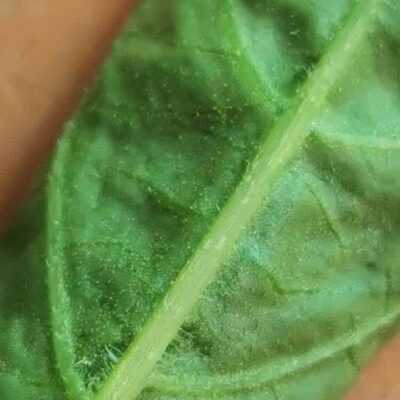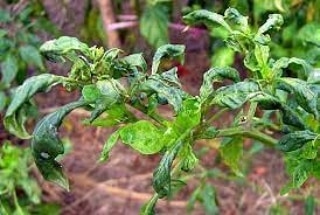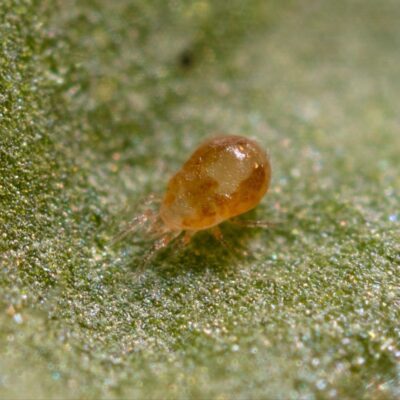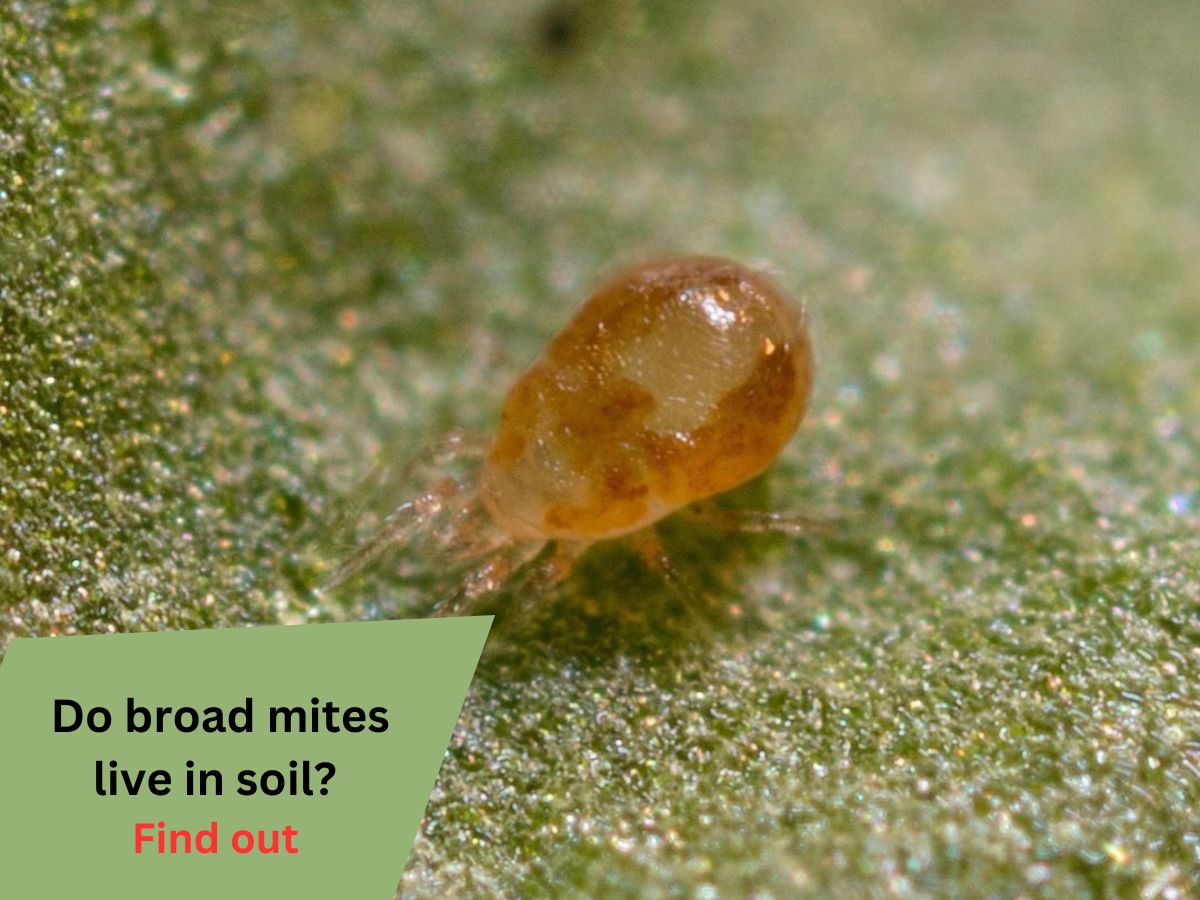As garden enthusiasts, we pour our hearts into nurturing lush greenery that adds life and beauty to our surroundings. But every now and then, unseen challenges arise in the form of tiny yet impactful pests. One such contender is the notorious broad mite (Polyphagotarsonemus latus), an arachnid that can wreak havoc on our cherished plants. In this exploration, we’ll shed light on the intriguing question: Do broad mites live in soil?
Broad mites, those minuscule troublemakers, are a force to reckon with. Their piercing-sucking mouthparts disrupt plant growth, causing distortion and discoloration. However, if you’ve been wondering whether they burrow beneath the soil’s surface, the truth unveils a different story.
In this exploration, we’ll unravel the mystery surrounding the habitat of broad mites. So, grab your gardening gloves as we embark on a journey to uncover where these sneaky pests truly reside and the impact they have on your cherished greenery.
Understanding Broad Mites
Broad mites, those minuscule but mighty pests, belong to the arachnid family, making them distant cousins of spiders and ticks. Despite their diminutive size, their effects on plants can be significant.
These tiny terrors possess piercing-sucking mouthparts, which they skillfully employ to extract the vital contents of plant cells. This feeding frenzy disrupts normal growth patterns and can lead to leaf distortion, discoloration, and an overall decline in plant health.
Characterized by their microscopic stature, broad mites are challenging to spot with the naked eye. Their translucent bodies and swift movements make detection even trickier. However, don’t let their size fool you – these seemingly invisible creatures can wreak havoc on your beloved plants, causing concern among gardeners striving for thriving greenery.
The Habits and Habitat of Broad Mites
Broad mites, these elusive creatures of the garden, have quite the knack for finding their ideal hangouts. They’re not too picky when it comes to their living arrangements. You’ll often find them setting up camp in environments that offer warmth and humidity, such as greenhouses, indoor gardens, and even outdoor plants during certain seasons.
But where exactly do they take shelter? Well, these tiny terrors have a penchant for the undersides of leaves and snug crevices within your plants. These hiding spots grant them easy access to their main course: the nutritious juices that flow through the plants’ vascular systems.
Their love for these hideaways makes them adept at avoiding human eyes. And as masters of stealth, they thrive in the warmth and humidity that nurtures their proliferation. So, whether you’re nurturing indoor foliage or cultivating outdoor blooms, these micro-menaces could very well be lurking, making it all the more essential to be on the lookout for their telltale signs.

Dispelling the Myth: Do Broad Mites Live in Soil?
Let’s debunk a common gardening myth – no, broad mites don’t typically call the soil their home. It’s a misconception that has led many green thumbs astray. While these microscopic troublemakers might be causing distress to your plants, their habitat is not beneath the soil’s surface.
Instead, broad mites prefer to establish their residences on the surface of leaves, particularly the undersides, and within the intricate folds of your plants. This preference for foliage is driven by their need to tap into the plant’s vascular system, feeding on the precious juices that fuel growth. So with this broad mites can’t live without plants.
While they may not dwell in the soil, it’s important to understand their actual haunts to effectively manage and prevent infestations. By clearing up this misunderstanding, we can focus on targeted measures that keep our plants – and the soil they call home – thriving.
The Real Hideout: Where Broad Mites Thrive
the secret world of broad mites unfolds on the surfaces of your beloved plants. These minuscule menaces have a knack for choosing hiding spots that maximize their impact. When it comes to their preferred haunts, two main locations steal the spotlight: plant surfaces and crevices.
The undersides of leaves become prime real estate for broad mites. They settle here to indulge in their favorite activity – feasting on the plant’s precious juices. These spots offer a protective cover, shielding them from direct sunlight and environmental fluctuations while providing easy access to their nourishing meals.
Crevices within your plants provide an additional layer of concealment. These tucked-away niches not only shield them from prying eyes but also offer a cozy environment where they can flourish. It’s their ability to thrive in these hidden realms that makes them such formidable foes for gardeners.
Understanding these favored locations is crucial for effective detection and control. Regularly inspect your plants, paying special attention to the undersides of leaves and tight corners where these tiny terrors may be plotting their havoc. By staying vigilant, you can uncover their presence and take action to protect your green companions.

Interaction with Soil: Indirect Effects
While broad mites might not take up residence in the soil, their actions can still have a ripple effect on both the soil and your plant’s well-being. Imagine this: as these stealthy arachnids feast on your plants’ juices, the leaves they infest might eventually drop to the ground. This seemingly harmless act sets off a chain reaction.
As the affected foliage decomposes, it becomes a potential breeding ground for other pests or pathogens in the soil. This could lead to a disruption in the delicate balance of your garden’s ecosystem, affecting soil health. Moreover, when plants are weakened due to mite infestations, they might struggle to establish robust root systems, impacting their ability to anchor themselves securely in the soil.
It’s a reminder that a garden is a complex web of interactions. While broad mites don’t directly call the soil home, their actions can indirectly influence its dynamics. Maintaining a vigilant watch over your plants’ health, along with preventive measures against these pesky mites, can help you preserve both the vibrant vitality of your plants and the intricate harmony of your garden’s soil.
Can Broad Mites Spread from Plant to Plant?
Broad mites can indeed spread from plant to plant, especially in environments where plants are closely situated. These microscopic invaders have a knack for hitching rides on various vectors, inadvertently moving from one host to another.
Here’s how this stealthy transmission occurs:
- Physical Contact: If infested leaves or plants come into direct contact with healthy ones, the mites can crawl onto the new host and establish themselves. This is particularly concerning in densely planted areas where leaves may touch or rub against each other.
- Airborne Movement: Though broad mites don’t possess wings, they can be carried short distances by air currents, especially in enclosed spaces like greenhouses or indoor gardens. This allows them to reach neighboring plants and initiate new infestations.
- Human Interaction: Gardeners, unknowingly, can also contribute to the spread of broad mites. Tools, hands, and clothing that have come into contact with infested plants can inadvertently carry mites to healthy ones.
- Insect Vectors: Some insects, like thrips and whiteflies, can serve as unwitting carriers of broad mites. When these insects move between plants, they can transport mites along with them.
Managing Broad Mite Infestations
Banishing broad mites from your garden requires a multi-pronged approach that targets both the pests and their potential hiding spots. Here’s a comprehensive strategy to help you effectively get rid of these tiny terrors:
- Inspection and Identification: Begin by closely inspecting your plants. Look for telltale signs like distorted leaves, curling, and discoloration. Confirm the presence of broad mites through a magnifying glass, as they’re challenging to see with the naked eye.
- Isolation: If you identify an infested plant, isolate it immediately to prevent the mites from spreading to other plants.
- Pruning and Removing Infested Parts: Trim and remove severely infested leaves and stems. Bag and dispose of them far from your garden to prevent reinfestation.
- Wash and Clean: Gently spray your plants with a strong stream of water to dislodge mites. Additionally, wipe down leaves using a mild soap and water solution to physically remove the pests.
- Natural Predators: Introduce natural predators like predatory mites (such as Neoseiulus californicus) that feed on broad mites. These beneficial insects can help keep the mite population in check.
- Beneficial Nematodes: Apply beneficial nematodes (Steinernema feltiae) to the soil. These microscopic organisms attack mite larvae in the soil, reducing their numbers.
- Insecticidal Soaps and Oils: Use insecticidal soaps or neem oil sprays, following the manufacturer’s instructions. These treatments suffocate and disrupt the mites’ cell membranes.
- Horticultural Oil: Apply horticultural oil during the dormant season to smother overwintering mites and their eggs.
- Repeat Treatments: Consistency is key. Repeat treatments at regular intervals to catch mites in different life stages.
- Environmental Factors: Maintain proper plant hygiene, manage humidity, and provide adequate spacing between plants. Healthy plants are less susceptible to mite infestations.
- Quarantine New Plants: Before introducing new plants to your garden, quarantine them for a period and inspect them thoroughly for signs of infestation.
Remember, getting rid of broad mites might require patience and persistence. Regular monitoring and early intervention are essential to preventing their resurgence and keeping your garden thriving. If the infestation is severe, consider seeking advice from a local horticulturist or pest control professional.

Do Broad Mites live in soil FAQs?
Can broad mites survive in soil for prolonged periods?
Broad mites typically do not thrive in soil for extended periods. Their preferred habitats are plant surfaces, especially the undersides of leaves, and crevices within plants. These locations provide them easy access to their plant hosts and the nutrients they need.
While they may come into contact with soil due to their feeding activities on plants, they are not adapted to live in the soil environment. Instead, they rely on the plant’s juices for sustenance and reproduction.
Are broad mites visible to the naked eye?
Broad mites are incredibly tiny, measuring around 0.1 to 0.2 millimeters in length. This minuscule size makes them difficult to see with the naked eye. Their translucent bodies and rapid movements further contribute to their invisibility.
To properly identify broad mites, a magnifying glass or microscope is essential for observing their characteristics, such as their oval shape and the presence of their piercing-sucking mouthparts.
Do broad mites harm humans?
Broad mites primarily feed on plants and are not known to harm humans directly. They have specialized mouthparts that are adapted for piercing plant tissues and extracting juices. If you come into contact with broad mites, they are unlikely to cause any harm or adverse reactions.
However, it’s advisable to avoid direct contact with any pests and to wash your hands after handling plants that might be infested with broad mites or other pests.
How do I differentiate broad mite damage from other plant issues?
Differentiating broad mite damage from other plant issues requires careful observation. Broad mite damage often manifests as distorted or curled leaves, stunted growth, and discoloration.
The leaves might exhibit a shiny or silvery appearance due to feeding damage. Unlike some other plant issues, broad mite damage tends to affect new growth more prominently. Examining the undersides of leaves with a magnifying glass can reveal the presence of the mites themselves or their eggs.
What are some natural predators of broad mites?
Several natural predators can help control broad mite populations. These include predatory mites such as Neoseiulus californicus, Amblyseius swirskii, and Phytoseiulus persimilis.
These beneficial mites feed on broad mites and their eggs, helping to keep their populations in check. Additionally, certain species of predatory insects like ladybugs and lacewings may also consume broad mites as part of their diet.
Introducing these natural predators into your garden can serve as an effective biological control method for managing broad mite infestations.
Conclusion
In the intricate tapestry of gardening, understanding the habits and habitats of broad mites is an essential thread. As we conclude this exploration, we’ve demystified the notion of whether broad mites live in the soil. These tiny terrors may not call the soil home, but their impact resonates across the entire ecosystem of your garden.
We’ve uncovered their preferred hideouts on plant surfaces and within the folds of leaves, where they sip on the lifeblood of your cherished greens. While they might be invisible to the naked eye, their effects are undeniable, causing leaf distortion and plant decline.
Importantly, we’ve addressed misconceptions – broad mites don’t reside in soil, but their actions can indirectly affect it. As affected foliage drops, it can become a breeding ground for other pests, underlining the delicate balance of your garden’s health.
Fear not, for armed with knowledge, you’re now equipped to tackle these challenges head-on. Employ integrated strategies, from natural predators and meticulous plant care to preventive measures, to bid adieu to these stealthy adversaries.
As you nurture your garden, remember that it’s not just the plants that flourish; it’s your understanding of their intricate interactions that truly make your garden thrive. With vigilance, care, and a touch of expertise, you’re prepared to create a garden that stands strong against the unseen forces that seek to disrupt its splendor.
